Django保證表單的正確顯示需要添加CSRF(防止網站跨站請求偽造而默認開啟的一種保護方式),在<form></form>之間添加
{% csrf_token %}
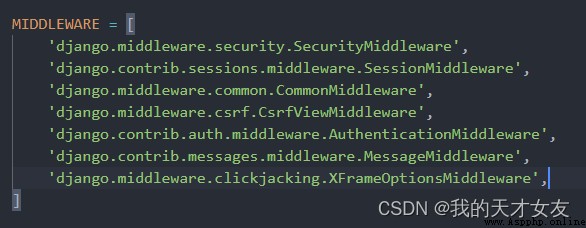
在項目settings.py中 * ‘django.middleware.csrf.CsrfViewMiddleware’, * 引入,如果沒有此中間件,手動添加。
首次打開路徑是GET請求,如果點擊上傳是POST請求,如果文件內容不為空,則上傳文件,上傳路徑為主項目下的 media/uploads/,如果路徑不存在則新建。open(os.path.join(path + myFile.name), ‘wb+’) 二進制讀寫打開對應文件,chunks()將文件分塊讀寫。
def upload_file(request):
if request.method == "GET":
return render(request, 'app1/upload.html')
if request.method == "POST":
myFile = request.FILES.get("myfile", None)
if myFile:
path = 'media/uploads/'
if not os.path.exists(path):
os.makedirs(path)
dest = open(os.path.join(path + myFile.name), 'wb+')
for chunk in myFile.chunks():
dest.write(chunk)
dest.close()
return HttpResponse("上傳完成")
else:
return HttpResponse("沒有上傳文件")
添加路由。

文件已經上傳成功。
如下新建一個form.py寫入如下代碼
from django import forms
class UserInfoForm(forms.Form):
'''用戶狀態'''
STATUS = ((None, '請選擇'), (0, '正常'), (1, '無效'),)
username = forms.CharField(label="用戶名稱", min_length=6, widget=forms.widgets.TextInput(
attrs={
'class': 'form-control', 'placeholder': '請輸入用戶名稱'}
))
password = forms.CharField(label="密碼", min_length=6, max_length=10, widget=forms.widgets.PasswordInput(
attrs={
'class': 'password'}, render_value=True
))
age = forms.IntegerField(label="年齡", initial=1)
mobile = forms.IntegerField(label="手機號碼")
status = forms.ChoiceField(label="用戶狀態", choices=STATUS)
createdate = forms.DateTimeField(label="創建時間", required=False)
配置視圖和路徑顯示對應表單
app1下的views.py
def userinfo_form(request):
if request.method == "GET":
myForm = UserInfoForm()
return render(request, 'app1/userinfo.html', {
'form_obj': myForm})
userinfo.html
<html>
<head></head>
<body>
<form action="" method="POST">
{% csrf_token %} {
{ form_obj.as_p }}
<input type="submit" value="提交" />
</form>
</body>
</html>
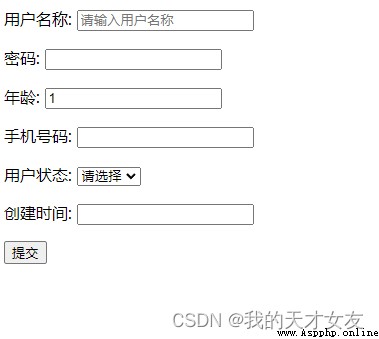

在form中添加如下代碼
class UserInfoForm__Msg(forms.Form):
'''用戶狀態'''
STATUS = ((None, '請選擇'), (0, '正常'), (1, '無效'),)
username = forms.CharField(label="用戶名稱", min_length=6, widget=forms.widgets.TextInput(
attrs={
'class': 'form-control', 'placeholder': '請輸入用戶名稱'}
), error_messages={
'required': '用戶姓名不能為空', 'min_length': '長度不能少於6位', 'invalid': '不能含有特殊字符'
})
password = forms.CharField(label="密碼", min_length=6, max_length=10, widget=forms.widgets.PasswordInput(
attrs={
'class': 'password'}, render_value=True
), error_messages={
'required': '密碼不能為空', 'min_length': '密碼不能少於6位', 'max_length': '密碼不能多余10位',
})
age = forms.IntegerField(label="年齡", initial=1, validators=[age_validate], error_messages={
'required': '年齡不能為空',
})
mobile = forms.IntegerField(label="手機號碼", validators=[mobile_validate], error_messages={
'required': '手機號碼不能為空',
})
status = forms.ChoiceField(label="用戶狀態", choices=STATUS, error_messages={
'required': '用戶狀態不能為空',
})
createdate = forms.DateTimeField(label="創建時間", required=False)
添加視圖
def userinfo_form_msg(request):
if request.method == "GET":
myForm = UserInfoForm__Msg()
return render(request, 'app1/userinfoform.html', {
'form_obj': myForm})
else:
f = UserInfoForm__Msg(request.POST)
if f.is_valid():
print(f.cleaned_data['username'])
else:
errors = f.errors
print(errors)
return render(request, 'app1/userinfoform.html', {
'form_obj': f, 'errors': errors})
return render(request, 'app1/userinfoform.html', {
'form_obj': f})
模板文件
<form action="" method="POST" novalidate>
{% csrf_token %}
<p>
{
{ form_obj.username.label }}:{
{ form_obj.username }} {
{ errors.username.0 }}
</p>
<p>{
{ form_obj.password}}{
{ errors.password.0 }}</p>
<p>{
{ form_obj.status.label }}:{
{ form_obj.status }} {
{ errors.status.0 }}</p>
<p>{
{ form_obj.age.label }}:{
{ form_obj.age }} {
{ errors.age.0 }}</p>
<p>{
{ form_obj.mobile.label }}:{
{ form_obj.mobile }} {
{ errors.mobile.0 }}</p>
錯誤信息匯總: {
{ errors }}
<input type="submit" value="提交" />
</form>
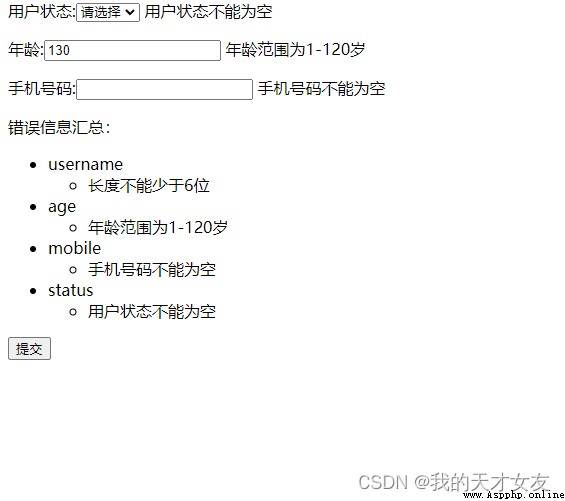
這裡還添加了表單的自我格式驗證,獲取表單的數據
模板文件:upload_form.html
<form enctype="multipart/form-data" action="" method="post">
{% csrf_token %} {
{ form_obj.as_p }}
<br />
<input type="submit" value="文件上傳" />
<img src="media/uploads/{
{ user.heading }}"
</form>
模型文件
在models.py中添加模型,這裡沒有主鍵默認會生成id的主鍵
class ImgFile(models.Model):
name = models.CharField(verbose_name='用戶名稱', max_length=300, default="")
heading = models.FileField(verbose_name='文件名', upload_to='media/uploads/')
def __str__(self):
return self.name
class Meta:
verbose_name = ' 用戶頭像信息'
db_table = 'user_img'
表單模型 form.py
class ImgFileForm(forms.Form):
name = forms.CharField()
heading = forms.FileField()
視圖模型
如果上傳了文件,將文件保存在對應的目錄下,並返回文件的信息。
def ingfileform(request):
if request.method == "GET":
f = ImgFileForm()
return render(request, 'app1/upload_form.html', {
'form_obj': f})
else:
f = ImgFileForm(request.POST, request.FILES)
if f.is_valid():
name = f.cleaned_data['name']
heading = f.cleaned_data['heading']
path = 'media/uploads/'
if not os.path.exists(path):
os.makedirs(path)
dest = open(os.path.join(path + heading.name), 'wb+')
for chunk in heading.chunks():
dest.write(chunk)
dest.close()
userimg = ImgFile()
userimg.name = name
userimg.heading = heading
userimg.save()
print('上傳成功')
return render(request, 'app1/upload_form.html', {
'form_obj': f, 'user': userimg})
else:
print(f.errors)
路由
re_path 配置了可以直接在浏覽器訪問對應的文件,
from django.urls import path, include, re_path
from django.views.static import serve
from mywed import settings
path('app1/userimg/', views.ingfileform),
re_path('media/uploads/(?P<path>.*)', serve,
{
"document_root": settings.MEDIA_ROOT}),
settings.py
這裡路徑在項目文件中設置便於統一,在實際的應用中也應該多在公共文件中設置
MEDIA_URL = "media/uploads/"
MEDIA_ROOT = os.path.join(MEDIA_URL, "")
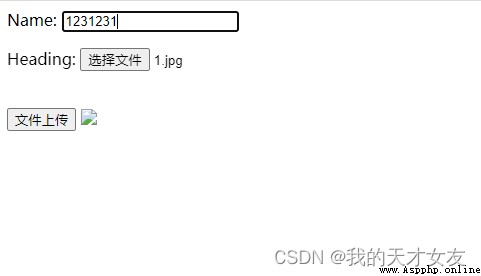

db中也登陸了對應的信息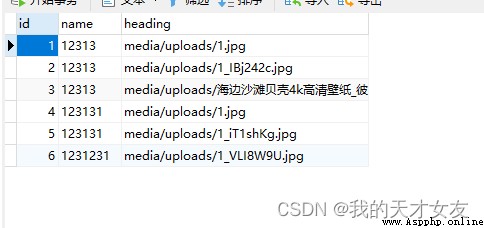
Django提供了ModelForm可以直接和模型關聯,省略了Form表單中定義的操作。
模板文件,為了能夠正常的訪問,必須添加csrfmiddlewaretoken或者在視圖函數中注釋@csrf_exempt,建議使用第一種方式
用戶名:<input type="text" id="username"></input>
密碼:<input type="password" id="password"></input>
{% csrf_token %}
<button id="submit">提交</button>
<script src="https://cdn.staticfile.org/jquery/1.10.2/jquery.min.js"></script>
<script> $("#submit").click(function(){
var csrf = $('input[name="csrfmiddlewaretoken"]').val(); $.ajax({
url: '/app1/ajax_login_data', type: "post", data: {
'username': $("#username").val(), 'password': $("#password").val(), 'csrfmiddlewaretoken': csrf }, success: function(data){
console.log(data) }, error: function(jqXHR, textStatus, err){
console.log(arguments); } }); }); </script>
視圖文件
from django.views.decorators.csrf import csrf_exempt
def ajax_login(request):
return render(request, 'app1/ajax.html')
# @csrf_exempt
def ajax_login_data(request):
if request.method == "GET":
HttpResponse("內部自己的url")
username = request.POST.get('username')
password = request.POST.get('password')
print(username)
if username == 'admin' and password == '123456':
return JsonResponse({
'code': 1,
'msg': "登陸成功"
})
else:
print("222")
return JsonResponse({
'code': 0,
'msg': "登陸失敗"

這裡使用的是網上的jquery地址,也可在settings.py匹配如下,在網站根目錄中創建static目錄,放入jquery文件。
<script src=“/statics/jquery.min.js”></script>
STATIC_URL = '/statics/'
STATICFILES_DIRS = [
os.path.join(BASE_DIR, "statics"),
]